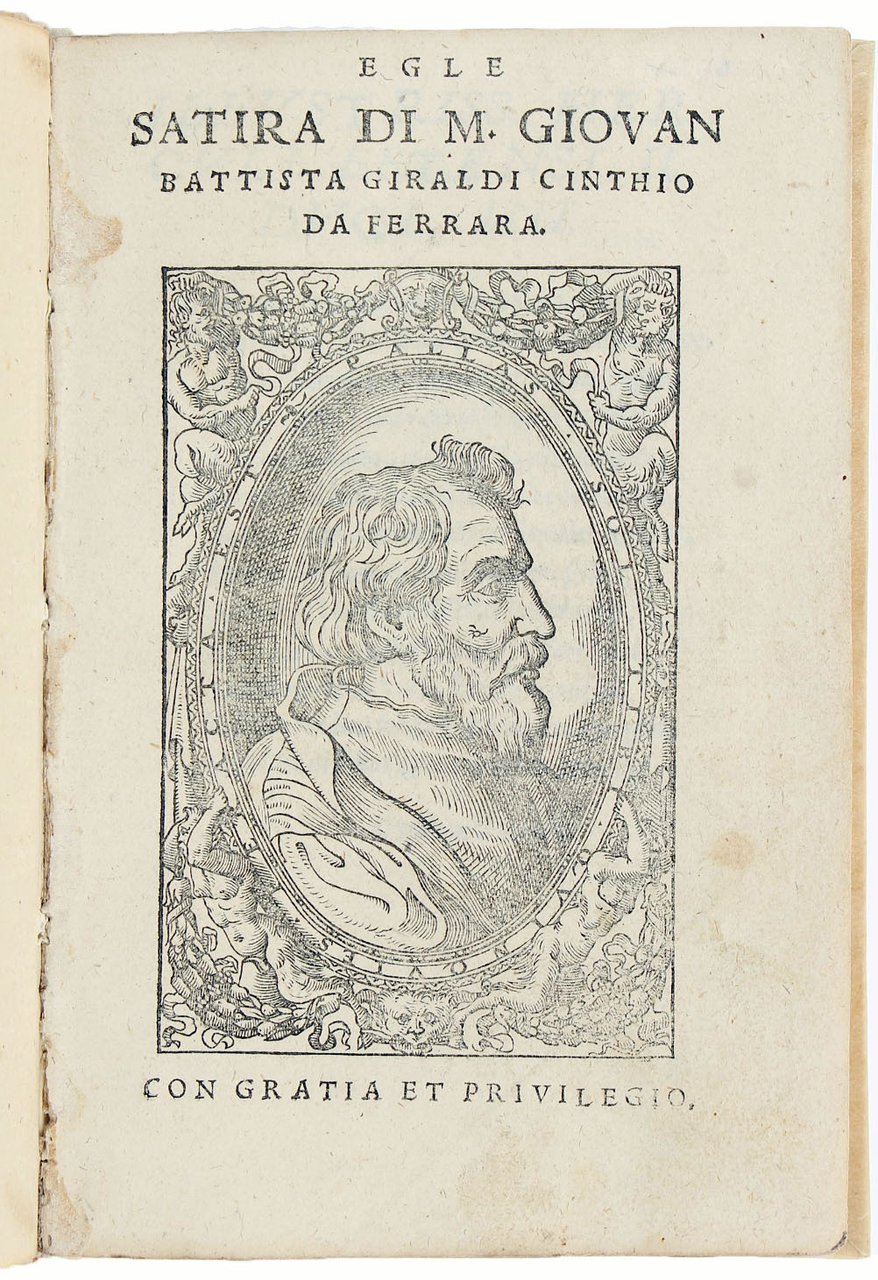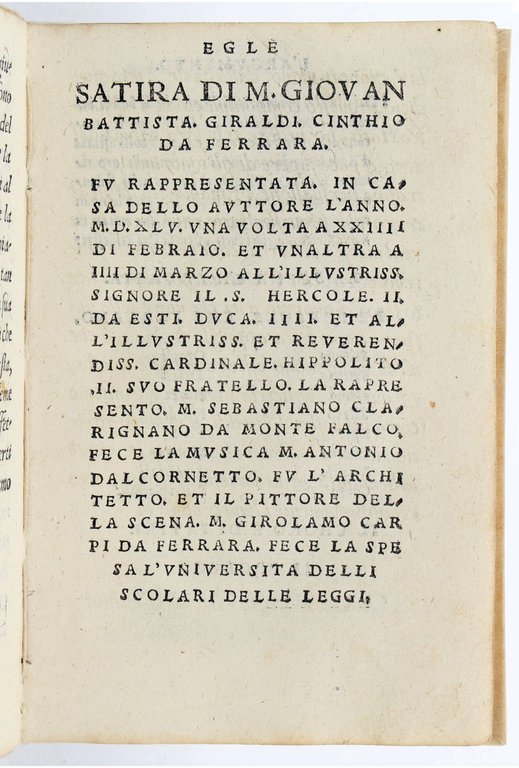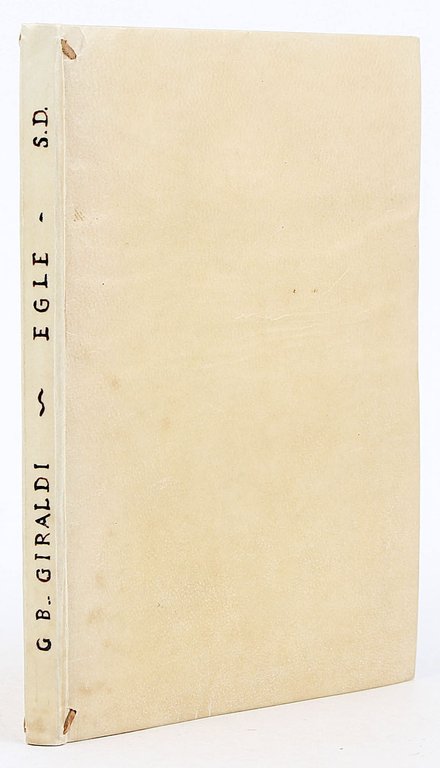


Libri antichi e moderni
GIRALDI CINZIO, Giovanni Battista (1504-1573)
Egle satira di M. Giovan Battista Giraldi Cinthio da Ferrara
[Niccolò Bascarini], [1545-1547]
1500,00 €
Govi Libreria Antiquaria
(Modena, Italia)
Le corrette spese di spedizione vengono calcolate una volta inserito l’indirizzo di spedizione durante la creazione dell’ordine. A discrezione del Venditore sono disponibili una o più modalità di consegna: Standard, Express, Economy, Ritiro in negozio.
Condizioni di spedizione della Libreria:
Per prodotti con prezzo superiore a 300€ è possibile richiedere un piano rateale a Maremagnum. È possibile effettuare il pagamento con Carta del Docente, 18App, Pubblica Amministrazione.
I tempi di evasione sono stimati in base ai tempi di spedizione della libreria e di consegna da parte del vettore. In caso di fermo doganale, si potrebbero verificare dei ritardi nella consegna. Gli eventuali oneri doganali sono a carico del destinatario.
Clicca per maggiori informazioniMetodi di Pagamento
- PayPal
- Carta di Credito
- Bonifico Bancario
-
-
Scopri come utilizzare
il tuo bonus Carta del Docente -
Scopri come utilizzare
il tuo bonus 18App
Dettagli
Descrizione
8vo (150x99 mm). 48 leaves. Collation: A-F8. On title page woodcut portrait of the author in a rectangular frame with the figures of four satyrs in each corner. Roman and italic types. Woodcut decorative initial. Modern flexible vellum, inked title on spine. On the front pastedown bookplate Sergio Colombi. Some occasional marginal foxing, but a very good copy.
Rare first edition (the work was published again only after the 18th century).
“With his Egle (1545) [Giraldi] aimed to create the first modern example of the ancient satyr-play and stimulate its revival” (L. Sampson, Pastoral Drama, in: “A History of Italian Theatre”, Cambridge, 2006, p. 95).
In the dedicatory letter to Bartolomeo Cavalcanti Giraldi states that the play was first staged in his house in Ferrara on 24 February 1545 and then again on March 4th, at the presence of Duke Ercole Il and his brother Cardinal Ippolito d'Este. From the dedication we also learn that the play was produced by Sebastiano Clarignano da Monte Falco, the music was composed by Antonio del Cornetto, the architect and painter of the scenery was Girolamo Carpi of Ferrara, and finally the production was paid by the “Università delli scolari delle leggi” (“University of law's students”).
The autograph manuscript of the play, which predates the printing and presents remarkable differences in respect of the printed edition like the absence of the prologue (cf. R. Drusi, Sul Prologo dell' ‘Egle' di Giovan Battista Giraldi Cinzio, in: “Quaderni Veneti”, 2, 2013, pp. 307-318), is still preserved in the Biblioteca Comunale of Ferrara (Classe I 331). In the library of the Archiginnasio at Bologna is preserved a copy of the present edition (16.a.II.70), in whose margins Giraldi has penned frequent corrections and alterations, the nature and extend of which suggest that it was his intention to bring out an improved version of the text, which, however, was never published. Therefore three different versions of the play are known, all of which can be traced back to the author (cf. C. Molinari, La vicenda redazionale dell' ‘Egle' di G.B. Giraldi Cinzio, in: “Studi di Filologia italiana”, 37, 1979, pp. 295-343; see also P.R. Horne, The Three Versions of G.B. Giraldi's satyr-play ‘Egle', in: “Italian Studies”, XXIV, 1969, pp. 32-43).
The printed version is based on the autograph manuscript version, reducing it from 2686 to 2274 verses and improving its scenic effectiveness according to the dictates that Giraldi himself would later theorize in his Lettera sopra il comporre le satire atte alla scena (1554) (C. Molinari, Introduzione, in G.B. Giraldi, “Egle; Lettera sovra il comporre le satire atte alla scena; Favola pastorale”, Bologna, 1985, pp. VII-XXXIII).
The printing place and the printer were identified by D.E. Rhodes in his paper The Printer of Giraldi's ‘Egle', in: “Italian Studies”, XLI, 1986, pp. 82-84. The date of printing has to be placed between March 1545 and 1747.
“The scene of Egle is Arcadia. The dramatis personae include satyrs, fauns, dryads, naiads, hamadryads, Pan, Silvanus, and Silenus. Egle, who gives her name to the play, is a nymph and consort of Silenus. The chorus is made up of satyrs. Cinthio's dedication leaves no doubt of his intention to represent a pastoral ideal: ‘I hope, and my hope will not be in vain, that in our time the name pastoral will be even as it once was in the golden age'. The prologue, which is in the detached Terentian manner and not an integral part of the action, gives the Arcadian setting. The audience is asked to return to nature, to the idealized nature of the golden past. There is no pretense of realistic representation. The plot of Egle resembles the Terentian pattern. The protasis, occupying Acts 1 and 2, introduces most of the principal characters and sets up the action. The epitasis runs throughout Acts 3 and 4 and into Act 5. The catastrophe occupies the last two scenes of Act 5. The chorus follows the patter

